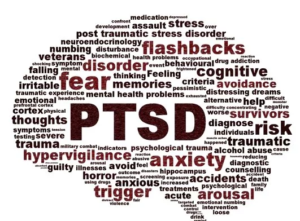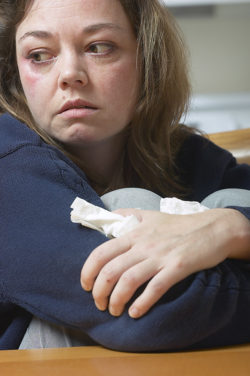July 17, 2017
PTSD? That only happens to people in the military, combat zones, war. Right?
Wrong! It can happen to anyone who has experienced, witnessed or is continually exposed to someone else’s trauma. It can happen to anyone, at any age.

Did you know? In the US:
• 7-8 people out of 100 will have PTSD at some point in their lives
• About 8 million people have PTSD during a given year
• 10% of women develop PTSD in their lifetime as compared to 4%
of men
• PTSD can be successfully treated
Recent immigrants from areas with considerable social unrest, wars and religious persecution may have higher incidences of PTSD.
The National Institute for Mental Health defines PTSD as:
An anxiety disorder that can develop after exposure to a terrifying event or ordeal in which there was the potential for or actual occurrence of grave physical harm. Traumatic events that may trigger PTSD include violent personal assaults, natural or human-caused disasters, accidents, and military combat. People with PTSD have persistent frightening thoughts and memories of their ordeal, may experience sleep problems, feel detached or numb, or be easily startled.

In particular, PTSD can negatively affect an individual’s mental health, physical health, work, and relationships. Sometimes individuals will develop unhealthy behaviors as a way of coping with their symptoms. Alcohol abuse and drug use are not uncommon.
Not everyone who experiences or witnesses a life threatening or traumatic act develops PTSD. Most people will experience symptoms of acute shock after such an event but if symptoms resolve within a month, they do not constitute PTSD. Many factors play a part in why a person may develop PTSD and others do not. Resilience factors or protective elements that may reduce risk of developing PTSD are:
• Seeking support from others after the trauma occurs
• Learning to feel good about how one responds to fearful or dangerous situations
• Having a positive coping strategy to get through a traumatic event and then learning from it
• Finding a support group
PTSD can occur with other mental health disorders such as agoraphobia, panic and depression.

The relationship between PTSD and depression is very consistent, though not necessarily cause and effect. PTSD is treatable. The main treatments are psychotherapy and medication. It is important to combine the two for maximum effectiveness.
How can you support and advocate for yourself or another if you believe you or a loved one have PTSD?
• Interact with other trauma survivors. They can be a source of understanding. You are not alone.
• Start exercising. Exercise can relieve tension. Check-in with your doctor before starting an exercise program.
• Consider change in neighborhood if feeling unsafe or living in high crime neighborhood.
• Avoid alcohol and drugs. If this has become a coping mechanism for you, consider a treatment program.
• Consider mindfulness practices.
• Consider professional help.
• Consider a companion pet.
• Continue or resume your spiritual practices.
• Practice sleep hygiene.
PTSD can be life changing, with moments of terror, panic and resulting physical distress. It is treatable. Life style changes and professional assistance can create a “new normal” that allows you to live a normal and fulfilling life.
Resources
What is PTSD from the VA
PTSD from NAMI
PTSD from NIMH





